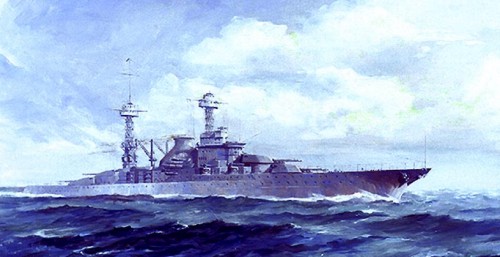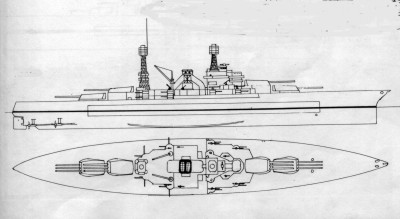

SPECIFICATIONS
Displacement: 43,200 tons (normal), 47,000 tons (full load)
Dimensions: 660 ft length x 104 ft 9 in beam
Guns: 12x16 inch 50cal (4x3); 16x6 inch 53cal (16x1); 4x3 inch A.A. (4x1)
Torpedo Tubes: 2x21 inch (beam. submerged)
Armor: Main belt 13-6 inch
SOUTH DAKOTA CLASS
| Ship | Laid Down | Cancelled | Completed | Built By |
| BB-49 South Dakota | 25 March 1920 | 08 February 1922 | 38.5% | New York Navy |
| BB-50 Indiana | 01 November 1920 | 08 February 1922 | 34.7% | New York Navy |
| BB-51 Montana | 01 September 1920 | 08 February 1922 | 27.6% | Mare Island Navy |
| BB-52 North Carolina | 12 January 1920 | 08 February 1922 | 36.7% | Norfolk Navy |
| BB-53 Iowa | 17 May 1920 | 08 February 1922 | 31.8% | Newport News |
| BB-54 Massachusetts | 04 April 1921 | 08 February 1922 | 11.0% | Bethlehem Quincy |
This class of six ships was the second part of the big program of naval expansion begun in 1916. When first authorised in 1917 they were the largest capital ships in the world and had the heaviest armament. The design was a logical development from the Colorado class, but with triple 16 inch replacing the twin turrets. However, the main belt armor was thinner and horsepower was increased in order to add two knots' speed.
Appearance: The published sketch designs show the South Dakotas to have been among the most outlandish looking battleships ever conceived, as they were to have had four funnels arranged in a square, but trunked into one pyramidal casing. The hull was basically similar to the Colorado's, but the secondary guns were arranged in an unusual series of double-storey casemates. The class also marked the return of the 6 inch gun to American battleships, a step which was not to be repeated in any capital ship completed for the U.S. Navy.
None of the class was laid down until 1920, by which time public agitation against the new program was growing. When it was learned that both the Japanese and British had taken the first steps towards building ships which would be individually superior to the American ships, and that a new naval arms race was looming, the U.S. Government wisely chose to call a halt. The result was the Washington Naval Disarmament Conference, following the ratification of which, the six South Dakotas were cancelled on 8 February 1922, along with the British and Japanese ships. The hulls were broken up in 1923 to clear the slipways.
Although the most powerful American ships of the period, and the most powerful in the world when laid down, the South Dakotas do not display the same blend of defensive and offensive power seen in the Colorados. The relatively thin belt and the idiosyncratic layout of secondary guns certainly do not compare with the simplicity and strength of the earlier class. Looking at them in retrospect one feels that they were conceived more to boost national prestige than to fulfill any pressing tactical fleet requirement.

SOURCE:
Last Updated 17 February 2000

